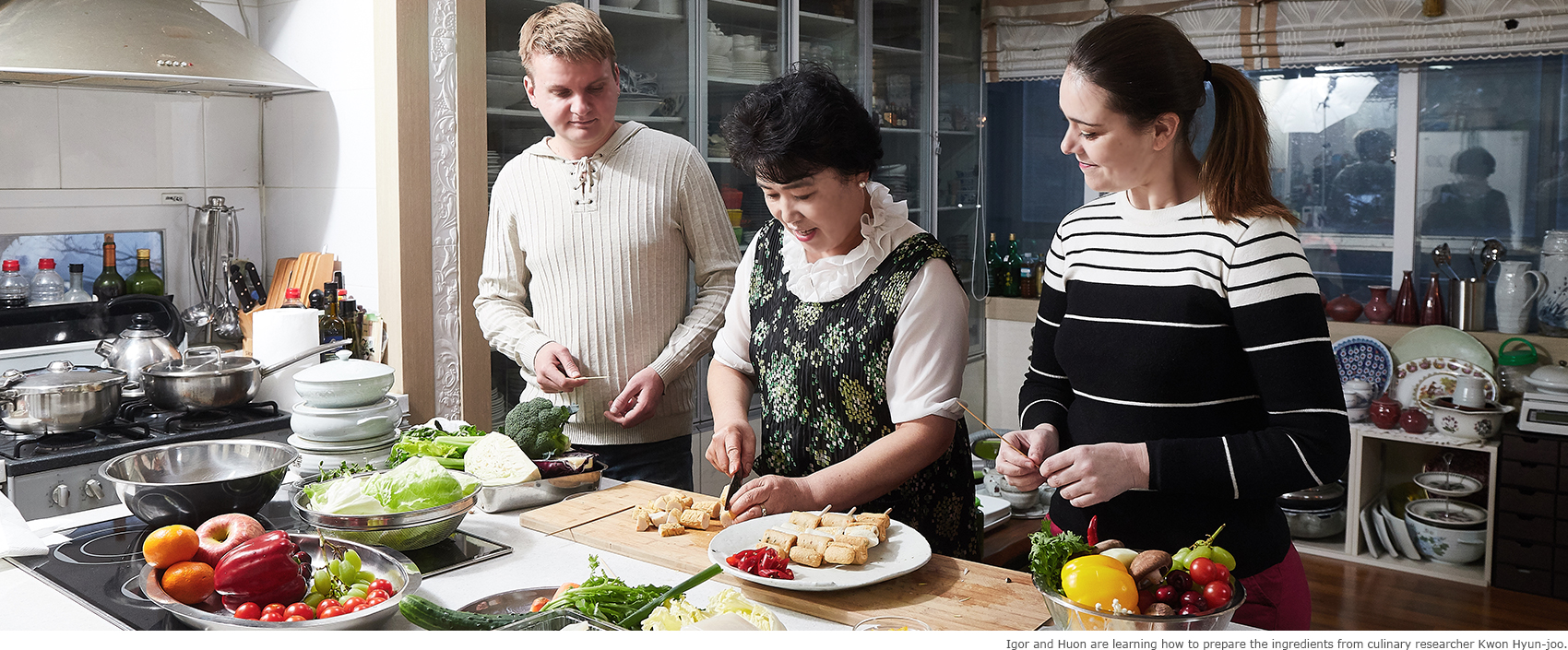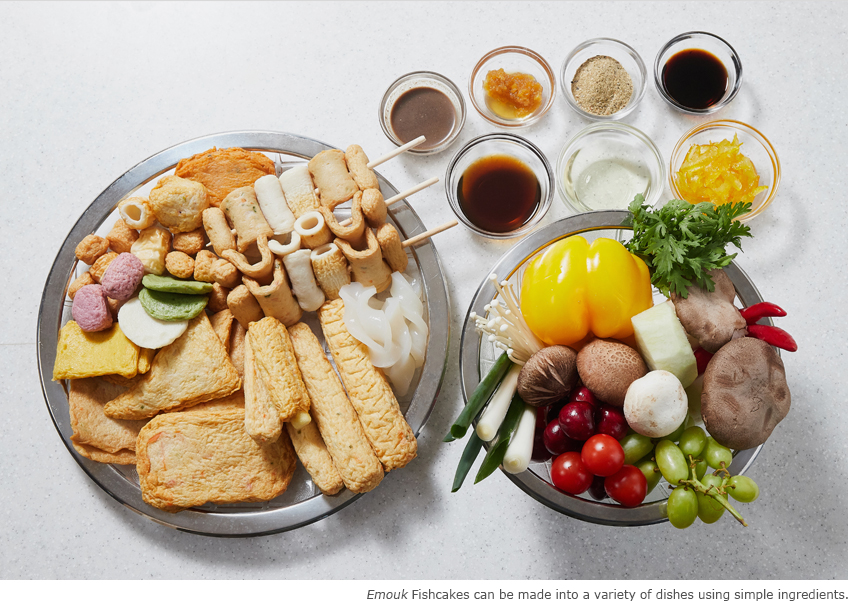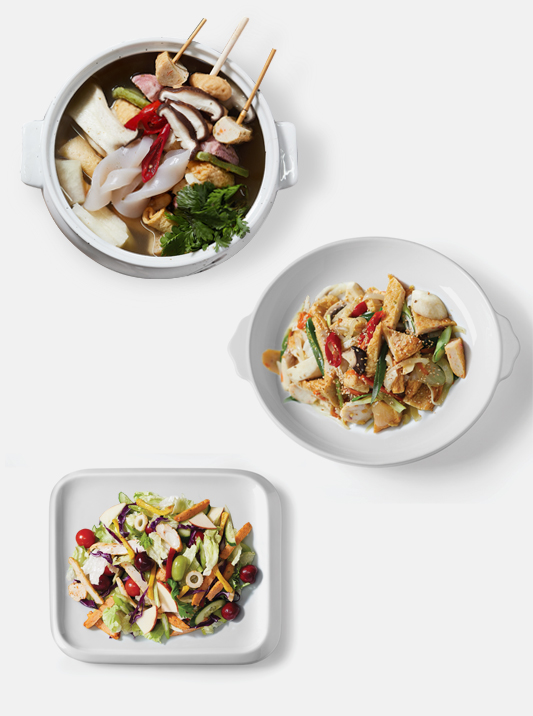

Chewy Temptation
in a Pot
Eomuk Fishcakes
Experience daily life in Korea through
eomuk fishcake cooking
“Winter feels particularly cold after the Spring, Summer and Autumn. At least this is the case in Korea. When the cold seeps into your coat and the biting wind freezes your fingers, what you want is a hot dish to warm you up. This is why eomuk fishcakes are such a popular street snack in Korea, enjoyed on the go in the frozen streets. Eomuk fishcakes are gaining popularity even among international diners, and we tried making some fishcake-based recipes with our international friends.”
Written by Park Ji-yeon Photographed by Studio Keun

Before Cooking Fishcakes
The first documented record of eomuk fishcakes in Korean cuisine can be found in the cookbook “Somunsaseol” written by Lee Pyo, a writer from the 1700s. According to him, a traveler who tried eomuk fishcakes in Japan called them gamabogot upon returning to Joseon. This is a reference to the Japanese style of kamaboko fishcake. In China, the fishcake is known to have originated from small balls made from fish meat, made to give the monarch some bone-free fish.
Although eomuk fishcakes have been enjoyed in Korea, China and Japan for centuries, they have developed in ways unique to each country. In Korea, eomuk gained widespread popularity from the 1970s to the 1990s as an affordable source of protein for the common folk.
Eomuk fishcakes are essentially made from cooked dough that contains chopped fish meat. This is a high protein and low fat food that contains unsaturated fats, calcium and iron, making it a healthy option. However, it's not advisable to overindulge, as it's relatively high in sodium. Popular eomuk fishcake dishes include stir fried eomuk with assorted vegetables, and eomuk soup with a refreshing radish broth. Eomuk soup, with its steaming hot broth is a well-loved winter fixture across the country.

Making Some Eomuk Recipes
With Igor Chernyak From Russia and
Huon Marina From France
We asked Igor and Huon if they had tried eomuk before. They replied that they had tried odaeng, but that they were unfamiliar with eomuk. Many people incorrectly refer to fishcakes as odaeng, but odaeng is actually boiled fishcakes, equivalent to eomuktang. Odaeng must have become synonymous with eomuk because the most popular way to consume eomuk is as a soup.
Software engineer Igor has lived in Korea for over 10 years. However, he has never tried eomuk before, being more of a beef or pork lover. Huon, who teaches French at a university here, enjoys spicy food, including stir-fried rice cake in a pepper sauce, or tteok-bokki, which contains fishcake. However, her interest picked up when she was told that we would make other dishes with the fishcakes. She expressed surprise, as she had always thought of fishcake as sideingredient, never as the main dish.
Variety of Eomuk Dishes:
Fishcake Soup, Fishcake Stir Fry,
Fishcake Salad
The biggest strength of eomuk is its versatility, which makes it suitable for many kinds of dishes. Moreover, it's simple to prepare. We used one pack of assorted eomuk to make a stir fry, a salad and a soup. The two assistant chefs were joined by culinary researcher Kwon Hyun-joo to guide their way. First, the assorted vegetables are washed. The radish that goes into the eomuk soup is cut into cubes, while the spring onion and mushrooms are sliced. The lettuce is shredded into bite-sized pieces. The eomuk to be used in the stir fry and salad are also sliced, while those that go into the soup are skewered in neat rows.
Igor and Huon are experienced home chefs and expertly cut the vegetables into thin slices. When frying
the eomuk, Huon suddenly picked up the pan and gave it a shake, saying, “You have to mix a stir fry like this”. Her skill, reminiscent of an experienced chef, surprised even the culinary researcher. The eomuk stir fry involves frying sliced fishcake together with vegetables, and finishing up with sesame oil. The eomuk salad is made by stir frying and then cooling down the fishcake, topping it onto a prepared bed of vegetables, and then adding a dressing. For the eomuk soup, skewered fishcake, mushrooms and other ingredients wee combined with the prepared broth and boiled. Soy sauce is added if more flavor is needed. It’s hadn't even been an hour since they began, but the three eomuk dishes were already all ready to go.
A New World of Fishcake
Finally the cooking was is done and it was time to eat! Culinary researcher Kwon Hyun-joo set the table with kimchi and steamed rice. Igor and Huon quickly finished their bowls of rice, together with the eomuk dishes and kimchi. When asked to rate their meal, Igor and Huon replied in unison, "A great experience!" They were especially impressed by the pairing of rice and the spicy eomuk stir fry with the red chili pepper flakes, and vowed to make eomuk fried rice for their friends someday. They want to prepare some hot fishcake soup on the side, containing chewy skewered eomuk, to be savored by their friends one by one. It was a new discovery for them that so many dishes could be made with eomuk. The easy recipes made this information particularly useful for foreign living in Korea, far away from their homes. The two marveled at the new world of eomuk that had been opened to them, and repeated the exclamation, "Delicious!" over and over.
One particular fishcake brand recently opened an outlet at Incheon International Airport. Now, eomuk fishcakes are more than just street food, having become a fixture on dinner tables across the nation, and even enjoyed internationally. As novel types of fishcakes, such as cheese fishcakes, sausage fishcakes and vegetable fishcakes, are constantly being developed to cater to a wider range of preferences, eomuk may be on an accelerated path to capturing the fancy of diners around the world. It's our hope that the food we eat every day will help shorten the gap between Korea and the rest of the world.


-
Cook Tip
Ingredients for Fishcake Soup
Assorted eomuk fishcakes of various shapes, a broth (anchovies, kelp, shrimp, mushrooms), radish, spring onion, konjac jelly, assorted vegetables (according to preference)
Ingredients for Eomuk
Fishcake Stir Fry Eomuk fishcakes (according to preference), broccoli, onion, spring onion, red chili (may be omitted), assorted vegetables (according to preference)
Ingredients for Eomuk Fishcake Salad
Eomuk fishcakes (according to preference), assorted fruits (cherries, celery, cherry tomatoes, etc.), cucumber, lettuce, paprika, bean sprouts
Citron dressing (citron marmalade, yogurt, olive oil, vinegar, sugar, onion concentrate)
Other Articles




Odaesan Mountain,
Pyeongchang’s Treasure

Hooked on Hangeul

Designed To Be ‘Held’


Eomuk Fishcakes


With Culture N Tickets
Application of subscription
Sign upThe event winners
Go






